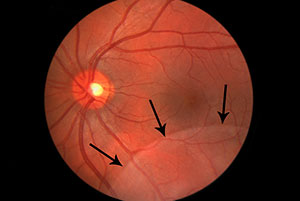
What is Retinoschisis?
Retinoschisis, also called vitreoretinal dystrophy or congenital retinal cyst, is a rare eye disorder. It is characterised by the splitting of the retina into two layers, leading to the formation of tiny cysts between the layers. These cysts damage the nerves in the eye and prevent light signals from reaching the brain, causing blurred vision.
Retinoschisis, if left untreated, may progress to retinal detachment. However, it is rare to become blind from retinoschisis.
What is the Retina?
The retina is the inner layer of the eye that consists of light-sensitive cells called rods and cones which help with vision in dim and bright lighting situations. The retina collects the visual signals and sends them through the optic nerve to the brain, where they are processed and interpreted as images.
What are the Different Types of Retinoschisis?
Retinoschisis is classified into two types. These include:
Congenital retinoschisis, also called juvenile, X-linked retinoschisis: This is present from birth and affects mostly boys and young men.
Senile/acquired retinoschisis: This can develop at any age; however, it is more common in middle-aged or older population.
What are the Causes of Retinoschisis?
Retinoschisis occurs when the retina splits into two layers. The exact cause of this split is unknown. However, juvenile retinoschisis is caused by inheriting a defective gene from the X chromosome, while senile retinoschisis is thought to occur due to degeneration of the eye as a person ages.
What are the Symptoms of Retinoschisis?
People suffering from retinoschisis may experience the following symptoms:
- Loss of visual acuity (the ability to recognize fine visual details with precision)
- Loss of peripheral vision
- Eyes may appear to look in different directions
- Bleeding in the eye may occur due to injured blood vessels
Acquired or senile retinoschisis is usually asymptomatic.
How is Retinoschisis Diagnosed?
Your eye specialist will perform a detailed eye exam reviewing your symptoms and medical history. To confirm retinoschisis, diagnostic tests are performed. These may include:
- Measurement of visual evoked response (VER): In this test, response of the eye to a light stimulus is recorded.
- Optical coherence tomography (OCT) scan: In this test, light waves are used to obtain detailed images of the retina to determine the extent of the retinal tear.
- Ocular ultrasound: In this test, high-frequency sound waves are used to obtain images of the retina.
- Gene test: This test is used to identify the RS1 gene that causes juvenile X-linked retinoschisis.
- Electroretinogram (ERG): In this test, a special sensor is placed within each eye. Then light is flashed on the eye and the response of the retina is recorded. The ERG measures the electrical activity of the retina.
What are the Treatment Options for Retinoschisis?
Senile retinoschisis may not require medical treatment as it is asymptomatic. However, if it is causing you trouble with vision, you should consult an eye specialist to explore a suitable therapy option.
For the treatment of juvenile X-linked retinoschisis, if bleeding occurs within the eyeball, the eye is kept as still as possible to help in blood coagulation. Later, laser treatment or cryotherapy: treatment with liquid nitrogen to freeze the damaged blood vessel, can be performed to seal the damaged portion in the retina.
If standard therapy options fail to provide relief, your eye specialist may recommend surgery to address the problem.
Related Topics
- Retinal Detachment
- Retinal Tear
- Diabetic Retinopathy
- Age-Related Macular Degeneration
- Retinal Vascular Diseases
- Retinal Artery Occlusion
- Retinal Vein Occlusion
- Retinal Hemorrhage
- Vitreous Hemorrhage of any Etiology
- Central Serous Retinopathy
- Posterior Vitreous Detachment
- Vitreomacular Traction Syndrome
- Epiretinal Membrane
- Macular Edema
- Macular Hole
- Retinoschisis
- Ocular Ischemic Syndrome
- Cystoid Macular edema
- Color Blindness
- Nyctalopia/Night Blindness
- Cone Dystrophy
- Choroideremia
- Retinopathy of Prematurity
- Uveitis & Ocular Inflammation
- Retinoblastoma

